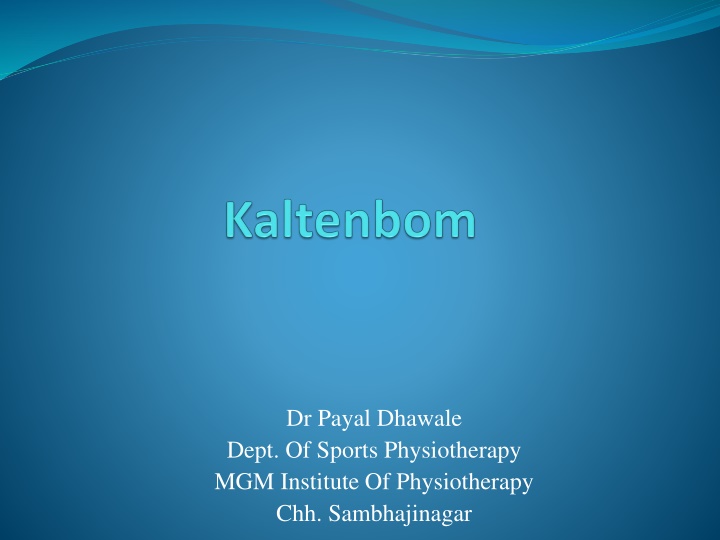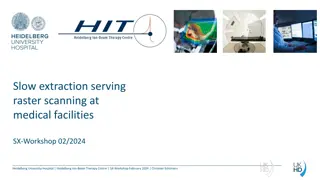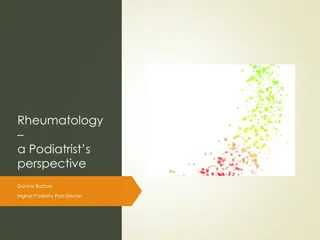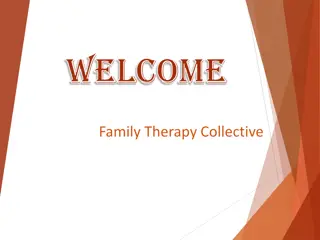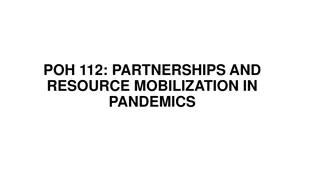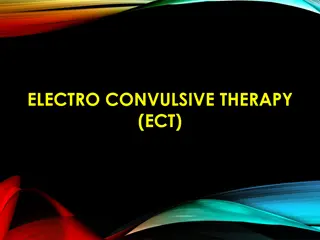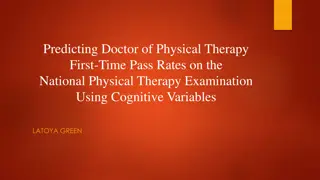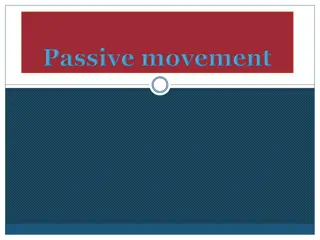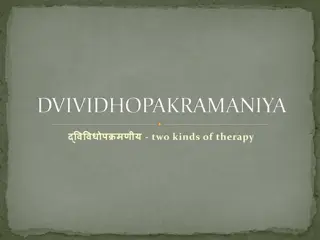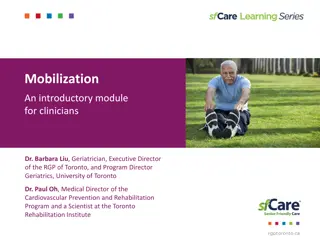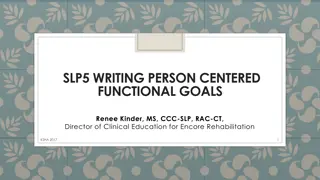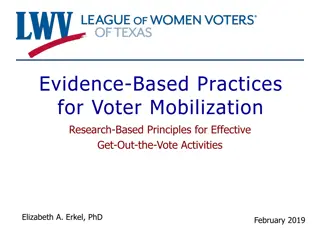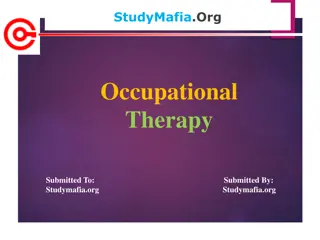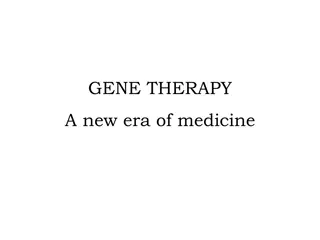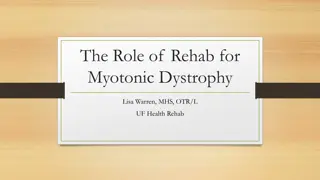Biomechanical Approach to Joint Mobilization Techniques in Physical Therapy
Physical Therapy, Joint Mobilization, Biomechanical Approach, Orthopedic Manipulative Therapy
Download Presentation

Please find below an Image/Link to download the presentation.
The content on the website is provided AS IS for your information and personal use only. It may not be sold, licensed, or shared on other websites without obtaining consent from the author.If you encounter any issues during the download, it is possible that the publisher has removed the file from their server.
You are allowed to download the files provided on this website for personal or commercial use, subject to the condition that they are used lawfully. All files are the property of their respective owners.
The content on the website is provided AS IS for your information and personal use only. It may not be sold, licensed, or shared on other websites without obtaining consent from the author.
E N D
Presentation Transcript
Dr Payal Dhawale Dept. Of Sports Physiotherapy MGM Institute Of Physiotherapy Chh. Sambhajinagar
Orthopedic Manipulative Therapy (OMT) importantspecialtyof physical therapy. Much of OMT is devoted to the evaluation and treatmentof the jointcomplex. When examination reveals especially decreased range hypomobility), the joint mobilization techniques are given is an joint of dysfunction, motion (i.e.,
Biomechanical approach to treatment and diagnosis Manipulative technique has changed over the past 50 years. Traditional manipulations rotational movements. produced by these long-lever rotational movements sometimes injured joints. In the 1940s, James Mennell, M.D. introduced shorter lever rotational manipulations which reduced the possibilityof jointdamage. In 1952 Norwegian manual therapists adopted these short- lever manipulative techniques applied compressive long-lever forces The
In 1954, translatoric linear bone movements, in the form of linear translatoric traction and gliding in relation to a treatment plane, to further reduce joint compression forces. Over the next 30 years kaltenbom worked to incorporate translatoric joint movements into a comprehensive joint evaluation approach that reduced the need for short-lever rotation mobilizations. kaltenbom introduced the concept of and treatment
By 1979, Evjenth and kaltenbom had refined their techniques to eliminate rotatory forces in extremity joint treatment, and by 1991 ,had accomplished the same forspinal manipulations. In the OMT Kaltenbom-Evjenth biomechanical principles form the core of the analysis and treatmentof musculoskeletal conditions. System,
Translatoric treatment in relation to the Kaltenbom Treatment Plane allows for safe and effective joint mobilization.
The therapist evaluates the translatoric joint play movements of traction and gliding by feeling the amount of slack in the movement and sensing the end-feel. The therapist uses grades of movement to rate theamountof joint play movementthey palpate. Three-dimensional joint applied before a test or mobilization, refines and directs the movement. positioning, carefully
The Kaltenbom Convex-Concave Rule allows indirect determination of the direction of decreased joint gliding to insure normal joint mechanics during treatment. The therapist evaluates and treats all combinations of movements, coupled and non-coupled. The therapist uses specific evaluation and specific treatment, including special symptomatic structures, and to treat hypermobility in addition to hypomobility. tests to localize
Combination of techniques The use of multiple treatment techniques, often in one treatment session, has always been part of our system. For example, techniques to improve joint mobility are often preceded by pain-relief mobilization techniques such as functional massage and musclestretching. and soft tissue-
Self-treatment is an important part of our system and may include instruction autostretching, autotraction, stabilization, orcoordination exercises. in automobilization, strengthening, Advice important to maintain improvements gained in therapy and to prevent recurrences. on body mechanics and ergonomics is
Trial treatment An experienced practitioner views any treatment procedurealsoas an evaluation procedure. Kaltenbom formalized this concept within his system in 1952, with the term "trial treatment," where the manual therapist confirms diagnosis with a low-risk trial treatment as an additional evaluation procedure the initial physical
Ergonomic principles for the therapist The OMT Kaltenborn-Evjenth System emphasizes good therapist body mechanics. An example of this was my development in the 1950's of the first pneumatic high-low adjustable treatment tabledesigned for manual physical therapy practice.
Their practitioners have since developed a number of treatment techniques and tools for efficiency and safety, including mobilization and fixation belts, wedges, and articulating tables
Extremity joint movement Joint anatomy Articular surfaces
Bony connections In most joint positions the articular surfaces are not fully congruent. The incongruence of joint partners is due to the differences in curvature of the articular surfaces, e.g., the convex partner is more curved (smaller radius of curvature) than its concave joint partner
Joints have traditionally been classified only by their morphology and mechanical characteristics
MacConaill's classification of joints MacConai ll describes four structural classifications of synovial joints which are correlated with the types of bone movements and the degrees of freedom allowed at each articular pair: Unmodified ovoid: (art. spheroidea), ball and socket, triaxial, e.g., hip and shoulder joints Modified ovoid: (art. ellipsoidea), ellipsoid, biaxial, e.g., metacarpophalangeal (MCP) joints Unmodified sellar: (art. sellaris), saddle, biaxial, e.g., first carpometacarpal joint Modified sellar: (art. ginglymus), hinge, uniaxial, e.g., interphalangeal joints
The joint complex, anatomical and physiological joint Anatomical Joint The anatomical joint consists of two articular surfaces -with the surrounding joint capsule, ligaments, and intra articular structures. These structures are classified as "inert (noncontractile) structures" I Intra-articular joint structures 2 Extra-articular joint structure
Joint complex Joint complex describes the anatomical joint plus all the surrounding soft tissues, including muscles, connective tissues, nerves and blood vessels The neuromuscular tissues within the joint complex, including muscles, tendons, tendon insertions and innervation, are classified as "contractile structures"
I Intra-articular joint structures 2 Extra-articular joint structures 3 Neuromuscular tissues 4 Skin and integument
Anatomical planes of reference The body is traditionally divided into three anatomical (cardinal) planes that are situated at right angles to each other and intersect at the body 's center of gravity. These planes of reference are used for describing and measuring anatomical bone movements
The median plane divides the body symmetrically into right and left halves and all planes parallel to this are called sagittal planes. Planes divide the extremities into right and left halves are called dorsal-ventral, dorsal-palmar, or dorsal- plantar planes.
The frontal plane divides the body into anterior (ventral) and posterior (dorsal) halves. Planes dividing the extremities into anterior and posterior halves are called medial-lateral, radialulnar, or tibial-fibular planes.
The transverse plane or horizontal plane divides the body into cranial and caudal halves and the extremities into distal and proximal halves
Kaltenbom Treatment Plane The Kaltenbom Treatment Plane passes through the joint and lies at a right angle to a line running from the axis of rotation in the convex bony partner, to the deepest aspect of the articulating concave surface. For practical purposes, you can quickly estimate where the treatment plane lies by imagining that it lies on the concave articular surface.
Anatomical axes of reference The anatomical axes lie at the intersection of two anatomical planes and anatomical bone movements take place around these axes. The frontal axis lies at the intersection of the frontal and transverse planes and runs from right to left. In the extremities, this axis is called transverse, medial-lateral, radial-ulnar, or tibial-fibular
The sagittal axis lies at the intersection of the sagittal and transverse planes and runs in a dorsal- ventral direction. The longitudinal (vertical) axis lies at the intersection of the sagittal and frontal planes and runs in a cranial-caudal direction. In the extremities, this axis passes through a part of a bone such as the neck of the femur or the entire length of a bone e.g., the shaft of the humerus, clavicle
Three-dimensional joint positioning The effectiveness of joint evaluation and mobilization treatment can be enhanced by placing the joint specifically in one, two, or three planes. For practical purposes, classify joint positions into five categories: Zero position Resting position (Loose-packed position) Actual resting position Non resting positions Close-packed position
Zero position All joint range of motion measurements are taken from the zero starting position, if possible. The range of motion is measured with a goniometer on both sides of zero.
For example, a movement of thirty degrees flexion and ten degrees extension is written: flexion/extension 30- 0-10. However, if there is limitation of movement, with movement only possible on the flexion side of zero, both figures are written on the left side of zero as in flexion extension 30-10-0 .
Resting position The resting position (loose-packed position) is the position (usually three-dimensional) periarticular structures are most lax, allowing for the greatest range of joint play With many joint conditions, this position is also the patient's position of comfort (symptom-relieving posture) affording the most relaxation and least muscle tension. where
The resting position is useful for: evaluating joint play through its range of motion, including end-feel, and diagnostic manipulations. treating symptoms with Grade I-II traction mobilization within the slack. treating hypomobility with Grade II relaxation- mobilization or Grade III stretch-mobilization and manipulations. to minimize secondary joint damage due to long periods of immobilization associated with casting and splinting.
Nonresting positions Many subtle joint dysfunctions only become apparent when the joint is examined outside the resting position (nonresting position) and can only be treated in such positions. Other nonresting positions are used to specifically position soft tissues for movement or stretch. Since nonresting positions allow less joint play, more skill is required to perform techniques safely in these positions. Novice practitioners applying stretch mobilizations in nonresting positions are more likely to overstretch tissues and cause injury.
Close-packed position The close-packed position is characterized by the following criteria: The joint capsule and ligaments are tight or maximally tensed. There is maximal contact between the concave and convex articular surfaces. For example, the shoulder is closepacked when it is positioned in maximal extension and external rotation . Articular surface gliding is maximally reduced and only slight separation with traction forces is possible. Joint play testing and mobilization is difficult to perform at or near the close-packed position.
Bone and joint movement Bone movements. The relation ship between a bone movement (osteokinematics) and its associated joint movements (arthrokinematics) forms the basis for many orthopedic manual therapy (OMT) evaluation and treatment techniques. movements produce associated joint
Two types of bone movements are important in kalternbom OMT system: Rotations: curved (angular) movement around an axis Translations: linear (straight-lined) movement parallel to an axis in one plane
Rotations of bone produce the joint movement of roll- gliding. Translations of bone result in the linear joint play movements of traction , compression, and gliding in relation to the Kaltenborn Treatment Plane. From a mechanical perspective, translations can be curved or linear
Bone movements Corresponding joint movements Rotatoric (angular) movement Roll-gliding Standard (anatomical, uniaxial) Combined (functional, multiaxial) Translatoric (linear) movement Translatoric joint play Longitudinal bone separation Traction away from the treatment plane Longitudin al bone approximation Compression towards the treatment plane Transverse bone movement Gliding parallel to the treatment plane
Rotations of a bone Active movements occur around an axis and therefore, from a mechanical viewpoint, are considered rotations. All bone rotations can be produced passively as well. There are two types of bone rotations: 1) Standard, uniaxial - MacConaill 's "pure, cardinal swing" 2) Combined, multiaxial - MacConaill 's "impure arcuate swing"
Standard bone movements Standard bone movements are bone rotations occurring around one axis (uniaxial) and in one plane. Standard movement is called "anatomical" movement when the movement axis and the movement plane are in anatomical (or cardinal) planes. Anatomical bone movements beginning at the zero position are useful for describing and measuring test movements. They provide a standardized communicating examination findings that can be reproduced by other health care professionals method for
Sagittal plane movements around a frontal axis Flexion from zero: Extension to zero: Extension from zero: Flexion to zero:
Frontal plane movements around a sagittal axis Right and left side bending: trunk or spinal movements occur in the frontal plane. Abduction: movements are away from the median or sagittal planes. Adduction: movements are towards the median or sagittal planes.
